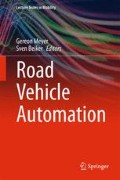Abstract
Interest in vehicle automation is at an all-time high, with many recent real-world demonstrations from a variety of companies and research groups. The key fundamental building blocks for automating vehicles have been in development for many years, making vehicle automation a near-term reality. Also in recent years, there have been significant efforts to make vehicles more energy efficient and less polluting, through the development of advanced powertrains and the development and promotion of alternative lower-carbon fuels, as well as traffic system operational improvements. With these two developing areas, one of the key questions is how will vehicle automation affect overall traffic energy efficiency and emissions. In this chapter, we briefly outline some of these potential impacts, examining issues such as vehicle design, vehicle and traffic operations, and even potential changes in activity patterns.
Access this chapter
Tax calculation will be finalised at checkout
Purchases are for personal use only
References
Transportation Research Board (2013) TRB’s second annual workshop on road vehicle automation. see http://www.vehicleautomation.org, July 2013
ICCVE (2013) 2nd International conference on connected vehicles and expo, Las Vegas Nevada. see http://www.iccve.org/, Dec 2013
Coelingh E, Solyom S (2012) All aboard the robotic road train: semiautonomous cars will play follow the leader, giving drivers a rest and saving fuel. In: IEEE spectrum, Oct 2012
Barth M, Boriboonsomsin K (2008) Real-world carbon dioxide impacts of traffic congestion. Transp Res Rec 2058:163–171
Browand F, McArthur J, Radovich C (2004) Fuel saving achieved in the field test of two tandem trucks. California PATH Research Report, report number UCB-ITS-PRR-2004-20
Mitra D, Mazumdar A (2007) Pollution control by reduction of drag on cars and buses through platooning. Int J Environ Pollut 30:90–96
Suzuki Y, Hori T, Kitazumi T, Aoki K, Fukao T, Sugimachi T (2010) Development of automated platooning system based on heavy duty trucks. In: 17th ITS world congress, TP058-1
Allaby P, Hellinga B, Bullock M (2007) Variable speed limits: safety and operational impacts of a candidate control strategy for freeway applications. IEEE Trans Intell Transp Syst 8(4):671–680
Vlassenroot S, Broekx S, De Mol J, Panis LI, Brijs T, Wets G (2007) Driving with intelligent speed adaptation: final results of the Belgian ISA-trial. Transp Res Part A 41:267–279
Barth M, Boriboonsomsin K (2009) Energy and emissions impacts of a freeway-based dynamic eco-driving system. Transp Res Part D 14:400–410
Boriboonsomsin K, Barth M, Zhu W, Vu A (2012) Eco-routing navigation system based on multisource historical and real-time traffic information. IEEE Trans Intell Transp Syst 13(4):1694–1704
Lavrenz S, Gkritza K (2013) Environmental and energy impacts of automated electric highway systems. J Intell Transp Syst Technol Plan Oper 17(3):221–232
Wu G, Boriboonsomsin K, Barth M (2014) Development and evaluation of an intelligent energy management strategy for plug-in hybrid electric vehicles. IEEE Trans Intell Transp Syst (in Press)
Author information
Authors and Affiliations
Corresponding author
Editor information
Editors and Affiliations
Rights and permissions
Copyright information
© 2014 Springer International Publishing Switzerland
About this chapter
Cite this chapter
Barth, M., Boriboonsomsin, K., Wu, G. (2014). Vehicle Automation and Its Potential Impacts on Energy and Emissions. In: Meyer, G., Beiker, S. (eds) Road Vehicle Automation. Lecture Notes in Mobility. Springer, Cham. https://doi.org/10.1007/978-3-319-05990-7_10
Download citation
DOI: https://doi.org/10.1007/978-3-319-05990-7_10
Publisher Name: Springer, Cham
Print ISBN: 978-3-319-05989-1
Online ISBN: 978-3-319-05990-7
eBook Packages: EngineeringEngineering (R0)

